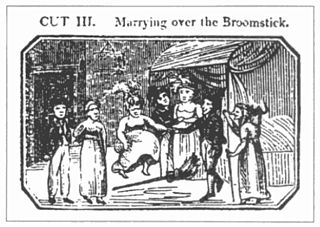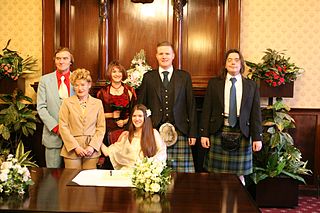Related Research Articles

Jumping the broom is a phrase and custom relating to a wedding ceremony where the couple jumps over a broom. It has been suggested that the custom is based on an 18th-century idiomatic expression for "sham marriage", "marriage of doubtful validity"; it was popularized in the context of the introduction of civil marriage in Britain with the Marriage Act 1836.

Lughnasadh or Lughnasa is a Gaelic festival marking the beginning of the harvest season. Historically, it was widely observed throughout Ireland, Scotland and the Isle of Man. In Modern Irish it is called Lúnasa, in Scottish Gaelic: Lùnastal, and in Manx: Luanistyn. Traditionally it is held on 1 August, or about halfway between the summer solstice and autumn equinox. But, in recent centuries some of the celebrations shifted to the Sundays nearest this date.
The banns of marriage, commonly known simply as the "banns" or "bans", are the public announcement in a Christian parish church or in the town council of an impending marriage between two specified persons. It is commonly associated with the Catholic Church, the Church of England, and the Church of Sweden, and with other denominations whose traditions are similar. In 1983, the Roman Catholic Church removed the requirement for banns and left it to individual national bishops' conferences to decide whether to continue this practice, but in most Catholic countries the banns are still published.

The Church of Ireland is a Christian church in Ireland and an autonomous province of the Anglican Communion. It is organised on an all-Ireland basis and is the second largest Christian church on the island after the Roman Catholic Church. Like other Anglican churches, it has retained elements of pre-Reformation practice, notably its episcopal polity, while rejecting the primacy of the Pope. In theological and liturgical matters, it incorporates many principles of the Reformation, particularly those espoused during the English Reformation. The church self-identifies as being both Catholic and Reformed. Within the church, differences exist between those members who are more Catholic-leaning and those who are more Protestant-leaning (evangelical). For historical and cultural reasons, the Church of Ireland is generally identified as a Protestant church.
Common-law marriage, also known as sui iuris marriage, informal marriage, marriage by habit and repute, or marriage in fact, is a legal framework in a limited number of jurisdictions where a couple is legally considered married, without that couple having formally registered their relation as a civil or religious marriage.

Marriage in the Catholic Church, also called matrimony, is the "covenant by which a man and woman establish between themselves a partnership of the whole of life and which is ordered by its nature to the good of the spouses and the procreation and education of offspring", and which "has been raised by Christ the Lord to the dignity of a sacrament between the baptised." Catholic matrimonial law, based on Roman law regarding its focus on marriage as a free mutual agreement or contract, became the basis for the marriage law of all European countries, at least up to the Reformation.

A Fleet Marriage was a common example of an irregular or a clandestine marriage taking place in England before the Marriage Act 1753 came into force on March 25, 1754. Specifically, it was one which took place in London's Fleet Prison or its environs during the 17th and, especially, the early 18th century.
A marriage license is a document issued, either by a religious organization or state authority, authorizing a couple to marry. The procedure for obtaining a license varies between jurisdictions, and has changed over time. Marriage licenses began to be issued in the Middle Ages, to permit a marriage which would otherwise be illegal.
Civil Partnership in the United Kingdom is a form of civil union between couples open to both same-sex couples and opposite-sex couples.
Same-sex marriage in the Republic of Ireland has been legal since 16 November 2015. A referendum on 22 May 2015 amended the Constitution of Ireland to provide that marriage is recognised irrespective of the sex of the partners. The measure was signed into law by the President of Ireland as the Thirty-fourth Amendment of the Constitution of Ireland on 29 August 2015. The Marriage Act 2015, passed by the Oireachtas on 22 October 2015 and signed into law by the Presidential Commission on 29 October 2015, gave legislative effect to the amendment. Marriages of same-sex couples in Ireland began being recognised from 16 November 2015, and the first marriage ceremonies of same-sex couples in Ireland occurred the following day.
The General Register Office for England and Wales (GRO) is the section of the United Kingdom HM Passport Office responsible for the civil registration of births, adoptions, marriages, civil partnerships and deaths in England and Wales and for those same events outside the UK if they involve a UK citizen and qualify to be registered in various miscellaneous registers. With a small number of historic exceptions involving military personnel, it does not deal with records of such events occurring within the land or territorial waters of Scotland, Northern Ireland or the Republic of Ireland; those entities' registration systems have always been separate from England and Wales.
A parish register in an ecclesiastical parish is a handwritten volume, normally kept in the parish church in which certain details of religious ceremonies marking major events such as baptisms, marriages, children, and burials are recorded. Along with these vital details, church goods, the parish’s response to briefs, and notes on various happenings in the parish were also recorded. These elaborate records existed for the purpose of preventing bigamy and consanguineous marriage.
Civil registration is the system by which a government records the vital events of its citizens and residents. The resulting repository or database has different names in different countries and even in different US states. It can be called a civil registry, civil register, vital records, and other terms, and the office responsible for receiving the registrations can be called a bureau of vital statistics, registry of vital records and statistics, registrar, registry, register, registry office, or population registry. The primary purpose of civil registration is to create a legal document that can be used to establish and protect the rights of individuals. A secondary purpose is to create a data source for the compilation of vital statistics.

Marriage is available in England and Wales to both opposite-sex and same-sex couples and is legally recognised in the forms of both civil and religious marriage. Marriage laws have historically evolved separately from marriage laws in other jurisdictions in the United Kingdom. There is a distinction between religious marriages, conducted by an authorised religious celebrant and civil marriages conducted by a state registrar. The legal minimum age to enter into a marriage in England and Wales is sixteen years, although this requires consent of parents and guardians if a participant is under eighteen. Certain relatives are not allowed to marry. For foreign nationals, there are also residency conditions that have to be met before people can be married. Same-sex marriage was introduced under the Marriage Act in March 2014.

The National Archives of Ireland is the official repository for the state records of Ireland. Established by the National Archives Act 1986, taking over the functions of the State Paper Office and the Public Record Office of Ireland. In 1991, the National Archives moved to its current premises in Bishop Street, Dublin. The Archives stand on the site of the Jacob's Factory, one of the garrisons held by rebels during the 1916 Easter Rising.

Marriage in Scotland is recognised in the form of both civil and religious unions between individuals. Historically, the law of marriage has developed differently in Scotland to other jurisdictions in the United Kingdom as a consequence of the differences in Scots law and role of the separate established Church of Scotland. These differences led to a tradition of couples from England and Wales eloping to Scotland, most famously to marry at border towns such as Gretna Green. The legal minimum age to enter into a marriage in Scotland is sixteen years and does not require parental consent at any age.
The Act for Marriages in England 1836, 6 & 7 Wm IV, c. 85 was an Act that legalised civil marriage in England and Wales from 1 January 1837.
Sir William Davys was an Irish barrister and judge who held the offices of Recorder of Dublin, Prime Serjeant and Lord Chief Justice of Ireland. He was suspected of Roman Catholic sympathies and was threatened with removal from the bench as a result, but he succeeded in retaining office until his death, due to his influential family connections.

The Marriage Act 1753, full title "An Act for the Better Preventing of Clandestine Marriage", popularly known as Lord Hardwicke's Marriage Act, was the first statutory legislation in England and Wales to require a formal ceremony of marriage. It came into force on 25 March 1754. The Act was precipitated by a dispute about the validity of a Scottish marriage, although pressure to address the problem of clandestine marriage had been growing for some time.
References
| This Irish history article is a stub. You can help Wikipedia by expanding it. |